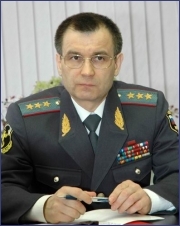
PUTIN’S ORDER TO CREATE MOUNTAIN TROOPS RESULTS IN COMPETING, HAPHAZARD FORCES
Publication: Eurasia Daily Monitor Volume: 4 Issue: 61
By:

In August 2004 Russian President Vladimir Putin announced the creation of two special army mountain brigades in the Northern Caucasus. The Defense Ministry initially promised that the brigades would be operational in 2005, but the deadline has shifted several times. As the Defense Ministry struggled to create the new units, Putin expressed his annoyance with the delay and demanded swifter action (Nezavisimoe voennoe obozrenie, January 26).
During this week’s televised meeting with cabinet ministers in the Kremlin, Putin ordered newly appointed Defense Minister Anatoly Serdyukov to report about the status of the mountain brigades (www.kremlin.ru, March 26). Serdyukov replied that the 33rd and 34th separate motorized infantry brigades will have a combined 4,566 troops, 1,156 have been already “selected” from other Army units, and all must be in place by October 1, 2007. Armaments and equipment for the new brigades, according to Serdyukov, will come from Defense Ministry arsenals, while some will need to be procured. Serdyukov added that the construction of a base for the 33rd brigade in Botlikh, high in Dagestan’s mountains near the Chechen border, is 30% complete, while the base of the 34th brigade at Zelenchukskaya in Karachaevo-Cherkessia, near Sochi and the Abkhaz border, is 50% complete. Both brigades must be formed and ready by December 1.
At the same meeting Putin asked Interior Minister Rashid Nurgaliev to outline how the MVD Interior Troops are preparing for mountain warfare. Nurgaliev reported that by next month up to 500 MVD Special Forces solders would be trained and equipped to fight in the mountains. In 2005 the MVD Interior Troops built a special mountain warfare-training center on the Khatsavata Mountain in Krasnodar Krai in the Northern Caucasus to drill their men (Nezavisimoe voennoe obozrenie, January 20, 2006).
Russia has been fighting rebels in the North Caucasus since 1994, and Russian peacekeepers are currently deployed in the mountainous South Ossetia and Abkhazia regions of Georgia. Future armed conflicts in the Northern and Southern Caucasus involving Russian forces remain a possibility. It seems rational that Putin has ordered the creation of special mountain forces, but little has been accomplished.
Putin asked for “mountain brigades,” but Serdyukov responded with a story about the creation of “separate motor-rifle brigades” that will be equipped with weapons from Russian arsenals. But such motor-rifle groups are heavy armored mechanized units, so what is actually being created?
In 1991 Russia had only one specialized mountain brigade that was based in Kyrgyzstan and disbanded after the Soviet collapse that December. Therefore, the officers and troops that will be “selected” from different regions of Russia to serve in the new brigades will have no mountain warfare training and it is not clear how they will in the future acquire knowledge of specific mountain fighting tactics in their new units (Nezavisimoe voennoe obozrenie, January 26).
Retired General Staff Colonel Georgy Kolivanov insists that the Russian defense industry cannot produce any special mountain-ready guns or other heavy infantry armaments for serious warfare (Nezavisimoe voennoe obozrenie, September 2, 2005). The Defense Ministry has procured, partially in the West, special clothing and mountaineering equipment, but it seems that the new units will mainly have regular army weapons.
The new brigades will be based deep in the Caucasus Mountains and cannot be easily moved anywhere else, especially from October to June, when snow hampers all movements in the region. Helicopters may fly small detachments of solders from the new brigades to battle outside their permanent basing area, but in the Caucasus helicopters may be grounded by bad weather for weeks in the fall and winter.
The 33rd brigade may use a relatively good mountain road from Botlikh into the Vedeno area of Chechnya to deploy for sudden action. In fact, the 33rd brigade’s main training ground has been placed near Vedeno (www.strana.ru, January 22). But neither the 33rd nor the 34th can possibly project force over the main Caucasian ridge into Georgia, or Abkhazia, or the Sochi area, since there are no roads — only trails fit for trained mountaineers and, possibly, pack animals.
In essence, the new “mountain” brigades will more or less be simple garrison troops outfitted to defend their strongholds and suppress local rebels. They cannot be easily or fully used in the Caucasus or anywhere else outside their basing area.
The special Interior Ministry mountain troops are by definition created for use inside Russia against insurgents and rebellions. The FSB (former KGB) has already deployed Special Mountain Border Guards in the Chechen mountains in the Itum-Kale region, but these are stationary defensive units. The commander of the Russian Airborne Troops (VDV), General Alexander Kolmakov, has announced that one of the VDV air-assault divisions will also specialize in mountain warfare. An air-assault division may possibly be better fit for speedy deployment to an out-of-base area, but it will most likely also lack special training and weapons to fight effectively high in the mountains.
In response to Putin’s command to organize mountain forces, Russia’s numerous parallel armies (FSB, MVD, VDV, Army) have created many, small, separate, badly prepared, and ineffective mountain units, with each service attempting to recruit, train, and arm the men as it sees fit. For once Putin tried to press through a sound idea, but Russia’s so-called power agencies responded by spending money to build a Potemkin village of detached “mountain” forces. It would have been much more expedient for the Kremlin to spend a trifle of its oil wealth to recruit a Gurkha brigade from Nepal to teach Russian solders proper mountain warfare tactics, sobriety, and discipline.




